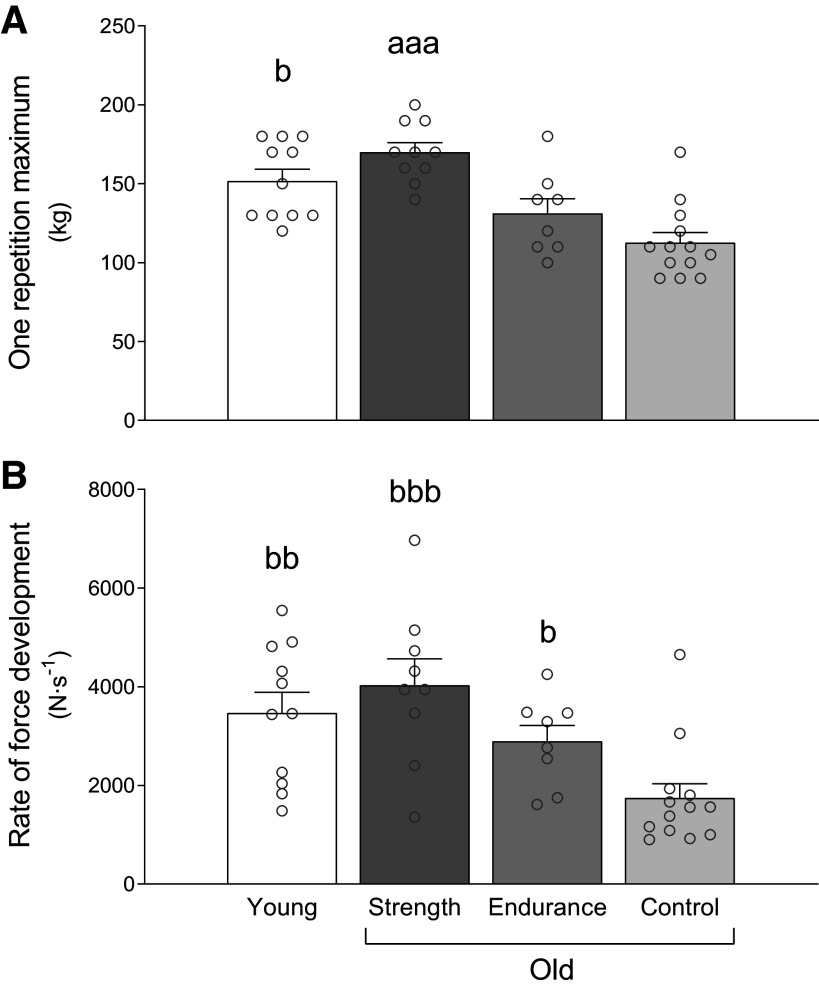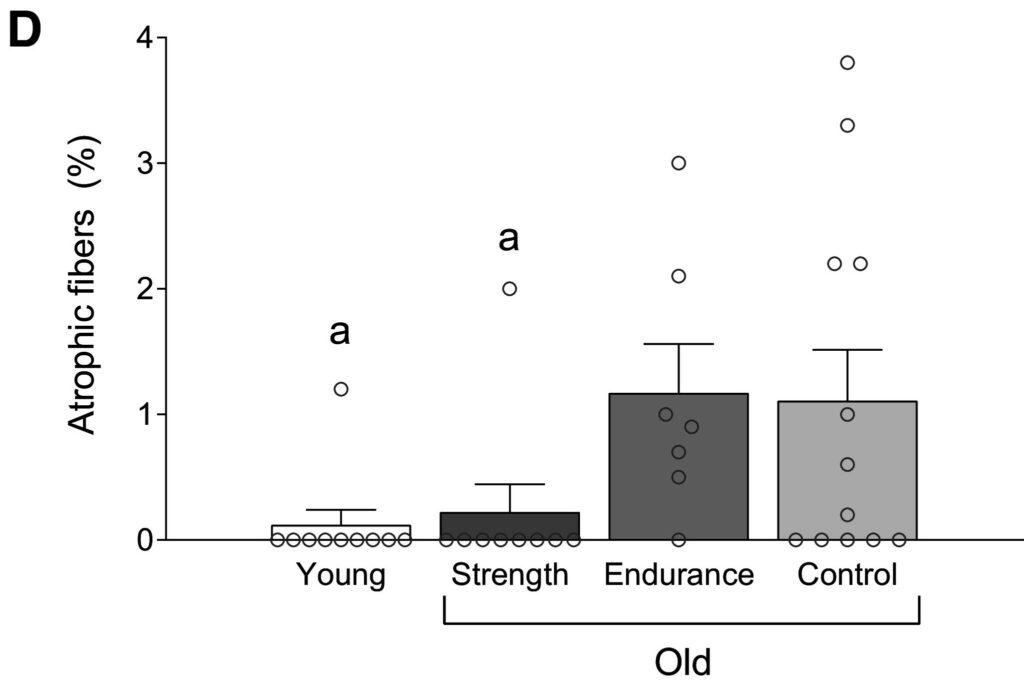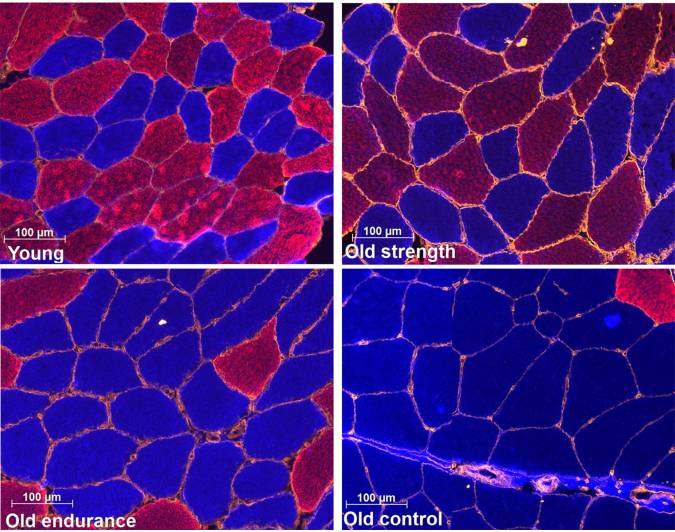A study in the Journal of Applied Physiology further demonstrates that strength training prevents muscle aging.
When we think of the difference between a youthful person and an elderly one, explosiveness and agility are the first things that come to mind. Jumping, sprinting, skipping, or landing from a height all require sudden, high force production. And, these are all things that are either dangerous or impossible for a frail elderly person.
One of the main reasons for this is that, as the decades pass and our lives become increasingly sedentary, we fail to use our very strongest muscle fibers. These fibers are called “fast twitch” fibers, and contract with more force and speed than the smaller “slow twitch” fibers. As these fast twitch fibers go unused, they eventually lose their innervation, and begin to atrophy. This means our bodies literally remove the nerve connections to these fibers so they can’t be used any more. Think of it like downsizing unused equipment. Eventually, they can either be replaced with fatty connective tissue. Or, if they get reactivated by a slow twitch motor neuron, they can even change to become the less powerful slow-twitch fiber form.
What this means is that if we had a way to prevent this loss of fast twitch muscle fibers, we would literally be preventing our muscles from aging. And strength training does exactly this.
This study shows that Strength Training is the Fountain of Youth!

Usually, the best we can do to see this effect is to compare active young people with elderly people and to see how their muscle fibers differ. But in this phenomenal study, researchers were able to really capture what is happening by comparing four groups of people:
- Young people (less than 30) who were recreationally active.
- Older people (over age 70) who did cardiovascular exercise.
- Older people (over age 70) who did strength training
- Older people (over age 70) who were recreationally active
The results are astounding – strength training prevents muscle aging!
To summarize them up front, only the strength trained older people had muscle tissue that looked young. The older individuals who did regular cardiovascular exercise are in many ways much healthier than those older individuals who simply lived an active lifestyle. But, when their muscle tissue was analyzed under microscope, it was clear that their muscles had still aged similarly to non-exercising seniors. Much of their fast twitch muscle tissue had either vanished or been replaced with slower twitch muscle.
By contrast, the older individuals who did regular strength training had muscle tissue that was almost identical to the that of the 30 year olds in the young-but-recreationally-active group! The fast twitch muscle fibers were still clearly visible.
Luckily, this free-access paper has some amazing graphics, each of which shows a key reason that strength training is the fountain of youth.
The strength-trained 70+ group was stronger and more powerful than the under 30 active group!
Incredibly, the older strength-trained group did more than simply slow their loss of strength and power. They actually exceeded the strength and explosiveness of the recreationally active young people! Despite being at least 40 years older, they demonstrated greater rate-of-force development, which is a key indicator of the youthful ability to generate sudden power for explosive activities.

Endurance trained seniors had similar fast twitch fiber atrophy to the non-exercisers, while strength trained elders had almost no atrophy!
Despite being consistent exercisers, the endurance-trained elders still showed a great deal of muscle fiber loss. This is because, despite their healthy habit of exercise, their chosen form of exercise simply didn’t involve recruiting the strongest muscle fibers. As I have written about before, even lots of activity can still allow for fast twitch muscle atrophy unless our exercise involves very explosive movements (which carry risk), OR meaningfully heavy weights lifted with control to near failure (much safer and just as effective).

The muscle fibers of strength-trained seniors look 40 years younger than those of their peers.
In the final graphic, we can see what the muscle fibers of each group look like under a microscope. These muscle cells have been stained with a dye that binds specifically to fast twitch fibers, and we can see that the strength trained seniors possess muscle fibers that look 40 years younger than their peers’!

There is NO SUBSITUTE for effective resistance training.
Beyond being robust, athletic, and resilient to injury, preserving our fast twitch fibers also keeps us young metabolically. Fast twitch fibers are like sponges for dietary carbohydrates – they run off of glycogen (stored glucose) and hungrily absorb blood sugar after they burn their available fuel during exercise. By preserving these fibers, we maintain our ability to eat an enjoyable diet without chronically elevated insulin levels, injurious blood sugar spikes, and relentless fat accumulation around our organs. And what this study shows clearly is that no amount of healthful activity or cardiovascular exercise can take the place of effective, meaningful, high effort strength training!
I know this is hard! After all, leg training in particular can be very difficult and uncomfortable. But the benefits are absolutely overwhelming. So stay strong, and maintain your habit of controlled resistance training with challenging loads that allow you to achieve thorough muscular fatigue safely.

